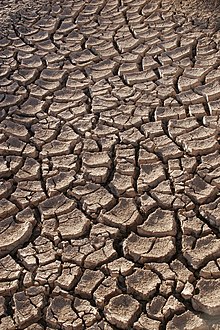Playa
Playa (plaja), takyr, kewir – odsłonięte dno bezodpływowego okresowego jeziora w klimacie gorącym i suchym, którego powierzchnię pokrywa stwardniały, spękany ił lub muł, silnie zasolony, z wykwitami węglanu wapnia, gipsu i soli kamiennej.
Tylko wyjątkowo po incydentalnych deszczach zamienia się on w grząskie błoto lub dno chwilowego jeziora wypełnionego wodą.
Nazwy regionalne
Słowo playa, pochodzące z Ameryki Północnej (Meksyk, południe USA), jest najczęściej stosowaną nazwą w literaturze naukowej, ale ta sama struktura ma swoje regionalne nazwy: kewir – w Azji, takyr – w Iranie i na południu dawnego ZSRR, sebha, shatt – na Saharze, w północnej Afryce.
Zobacz też
- takyry
- sołonczaki
- sołońce
- Racetrack Playa
Bibliografia
- Gradziński R. et al., 1986. Zarys sedymentologii. Wyd. Geolog. Warszawa.
- W. Jaroszewski, L. Marks, A. Radomski, 1985: Słownik geologii dynamicznej. Wyd. Geologiczne, Warszawa.
Media użyte na tej stronie
In order to comply with the use and licensing terms of this image, the following text must must be included with the image when published in any medium, failure to do so constitutes a violation of the licensing terms and copyright infringement: © Tomas Castelazo, www.tomascastelazo.com / Wikimedia Commons, CC BY 3.0
Wysuszona ziemia na pustyni Sonora w Meksyku.

